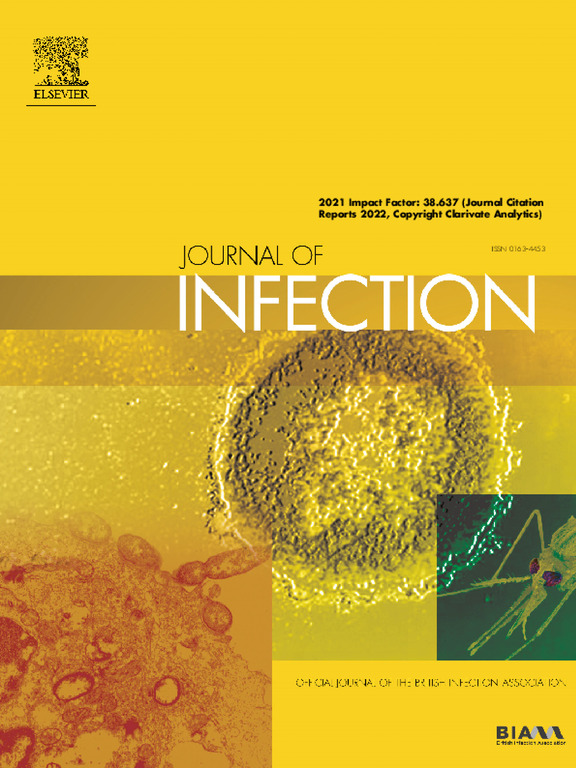Independent and interactive effects of viral species on early-life lower respiratory tract illness
IF 11.9
1区 医学
Q1 INFECTIOUS DISEASES
引用次数: 0
Abstract
Objectives
To determine the association between viral species and odds of severe lower respiratory tract illnesses (sLRI) versus upper respiratory illness (URI) among children under 2 years of age.
Methods
Infants (n=2061) enrolled in the Puerto Rican Infant Metagenomic and Epidemiologic Study of Respiratory Outcomes were surveilled for respiratory illnesses until age 2 years (March 2020 to April 2024). Nasal swabs from 1363 illnesses (774 participants) were screened for 21 pathogens.
Results
RSV infections occurred in 23% of sLRIs and increased odds of sLRI vs URI (OR=9.28; 95% CI, 5.43–15.85). Metapneumovirus, parainfluenza, and non-SARS-CoV-2 coronavirus also increased odds of sLRIs, while SARS-CoV-2 was associated with lower risk of sLRIs. Rhinovirus (43%) and bocavirus (16.1%) were commonly detected, but were not associated with sLRI risk. Co-infection with multiple viral species was associated with 2.92-fold greater odds of sLRI (95% CI, 2.05–4.16) compared to single viral species infections. Rhinovirus-bocavirus was the most common co-infection, and interaction between these viruses was associated with increased odds of sLRI.
Conclusions
Diverse viral pathogens drive early-life sLRIs. Some (e.g. RSV and metapneumovirus) have an intrinsic propensity to cause sLRIs, while other viruses’ lower airway pathogenicity depends on other factors, including co-infection.
病毒种类对生命早期下呼吸道疾病的独立和相互作用。
目的:确定病毒种类与2岁以下儿童严重下呼吸道疾病(sLRI)和上呼吸道疾病(URI)发病率之间的关系。方法:参与波多黎各婴儿呼吸结局宏基因组学和流行病学研究的婴儿(n= 2061)在2岁之前(2020年3月至2024年4月)接受呼吸疾病监测。对来自1363名患者(774名参与者)的鼻拭子进行了21种病原体筛查。结果:23%的sLRI发生RSV感染,sLRI与URI的几率增加(OR=9.28; 95% CI, 5.43-15.85)。偏肺病毒、副流感病毒和非SARS-CoV-2冠状病毒也增加了sLRIs的几率,而SARS-CoV-2冠状病毒与sLRIs的风险较低相关。鼻病毒(43%)和bocavavirus(16.1%)常被检测到,但与sLRI风险无关。与单一病毒种感染相比,多重病毒种合并感染sLRI的几率高出2.92倍(95% CI, 2.05-4.16)。鼻病毒-博卡病毒是最常见的合并感染,这些病毒之间的相互作用与sLRI的几率增加有关。结论:不同的病毒病原体驱动早期slri。一些病毒(如RSV和偏肺病毒)具有引起sLRIs的内在倾向,而其他病毒的低气道致病性取决于其他因素,包括合并感染。
本文章由计算机程序翻译,如有差异,请以英文原文为准。
求助全文
约1分钟内获得全文
求助全文
来源期刊

Journal of Infection
医学-传染病学
CiteScore
45.90
自引率
3.20%
发文量
475
审稿时长
16 days
期刊介绍:
The Journal of Infection publishes original papers on all aspects of infection - clinical, microbiological and epidemiological. The Journal seeks to bring together knowledge from all specialties involved in infection research and clinical practice, and present the best work in the ever-changing field of infection.
Each issue brings you Editorials that describe current or controversial topics of interest, high quality Reviews to keep you in touch with the latest developments in specific fields of interest, an Epidemiology section reporting studies in the hospital and the general community, and a lively correspondence section.
 求助内容:
求助内容: 应助结果提醒方式:
应助结果提醒方式:


